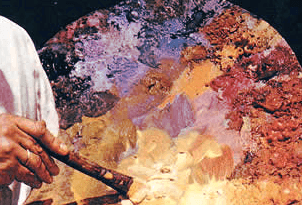BEYOND CADMIUM TO MORE COLORS!
At one point, cadmium red was thought to be a safer alternative to vermilion (cinnabar). Because of the mercury in vermilion, it was considered the death sentence for miners. However cadmium is not really that much better. It accumulates in the body, gives no warning symptoms, and is considered by OSHA to be “extremely toxic”. For this reason most paint manufacturers have created less toxic replacements. These alternatives will often be labeled “Cadmium Hue”, or will sometimes carry the name of the manufacturer, such as “Brandname Red”.
Since the development in 1911 of hansa (azo) yellow, there have been many alternatives to cadmium introduced. Hanza yellow is cooler than cadmium yellow – not a perfect match – and so is combined with other pigments to create a hue. Indian yellow is closer to cadmium, but has it’s own unique qualities such as larger pigment particles, making it more opaque. Quinacridone is an excellent pigment used for making cool reds. However, not until napthol red was introduced did a decent warm red become available as a cadmium alternative.
The attached image with six samples shows a selection of yellows and reds for comparison. Of particular interest is the extremely high chroma of the napthol red. Old Holland sells this as Schevening Red Medium. It is deep, intense, permanent, and semi-transparent. The hansa yellow shown is used by many artists in combination with other pigments. Indian yellow is warmer, and is worthy of more attention than it gets. The quinacridones are unsurpassed for magentas. This particular madder red is a quinacridone mix that has much better lightfastness than traditional madder.
In the end, some people will hold on to a favorite color regardless of toxicity issues, but there are less toxic close approximations to cadmium available from multiple sources. In addition to looking for a perfect cadmium substitute, it might be interesting to experiment with new alternatives, and thereby discover new color combinations. For example, some artists paint a transparent glaze as a base color stroke, and then add a high chroma layer on top. The effect can be quite stunning. The possibilities for new effects are endless, with the wide range of colors now available!




